Layering colors in acrylic pour paintings can be incredibly fun, and also beautifully challenging! Start with a thick opaque base to keep things bright and sharp. Then, add transparent paints on top to create stunning depth. Think of it like adding whipped cream over a brownie—delicious, right? Adjust your paint’s viscosity with pouring mediums to control how they blend—thicker paints hold tight layers, while thinner ones spread smoothly. Just be careful to avoid mixing complementary colors to dodge those muddy brown tones. If you’re keen to discover more enthralling techniques and tips, you’re on the right path!
Key Takeaways
- Use opaque paints as the base layer to maintain brightness and prevent muddiness.
- Layer transparent paints over opaque to enhance visual depth and vibrancy.
- Balance the number of transparent and opaque layers to avoid unwanted darkening.
- Choose a suitable pouring medium to control paint transparency and vibrancy.
Setting Up Your Pour
When setting up your pour, confirm you have at least 1.5 ounces of each paint ready for six by six tiles, totaling approximately two ounces of paint per tile for ideal coverage. This careful pour setup guarantees that each tile receives an adequate amount of paint, allowing for smooth and consistent coverage.
Now, let’s explore the nitty-gritty of paint preparation.
First, make certain your pouring medium is ready to go. This step is vital, as the pouring medium can change the opacity of your paints, impacting how your final artwork looks. Think of it like baking a cake—the right ingredients in the right amounts make all the difference.
Also, keep an eye on the viscosity of your paints. Different paints have different thicknesses, and this can affect how they mix and layer on your tile. Imagine trying to spread peanut butter and honey together; they each move differently, right? The same thing happens with paints.
Lastly, using the ring pour technique can help create those distinct, eye-catching layers. This method involves pouring your paint in concentric circles, which can add depth and interest to your painting.
Choosing Paint Colors
Selecting the right paint colors is fundamental to achieving compelling and visually dynamic acrylic pour paintings. To create depth and complexity, consider a mix of both opaque and transparent paints. This layering technique allows opaque colors to retain their brightness, while transparent paints can subtly darken the hues beneath them, enriching the overall composition.
Understanding the color wheel is vital for maintaining color harmony in your artwork. For instance, mixing complementary colors like orange and blue can result in muted, brownish tones. As a result, strategic selection and combination of colors are essential to avoid unintended muddiness in your pours.
| Color Type | Characteristics |
|---|---|
| Opaque | Brightness remains consistent regardless of layering |
| Transparent | Creates darker hues when layered over other colors |
| Complementary | Mixing can result in muted or brownish tones |
| Pouring Medium | Alters opacity, enhancing or diminishing color vibrancy |
To preserve vibrancy and clarity, it’s advisable to use a single opaque layer beneath multiple transparent layers. The addition of a pouring medium can also influence the final appearance, affecting opacity and color vibrancy. By carefully considering these factors and using complementary colors judiciously, artists can achieve a balanced and harmonious composition in their acrylic pour paintings.
Understanding Paint Viscosity
Understanding the role of paint viscosity is fundamental in mastering the art of acrylic pour painting, as it directly influences how colors interact and layer upon each other.
Paint viscosity, or thickness, plays an essential part in the paint flow during the pour. Thicker paints, like Titanium White, tend to stay put, creating more defined layers, whereas more liquid paints, like Burnt Sienna, spread easily and mingle with other colors, affecting the overall visual outcome.
When experimenting with different paints, it’s clear that viscosity adjustments can make or break your masterpiece. If the paint is too thick, it might not spread enough, leading to uneven coverage. On the other hand, if it’s too thin, it can dilute the colors, making them less vibrant and more prone to mixing.
Proper management of paint viscosity is key to achieving the desired depth and coverage in your pour. By diluting your paints with a pouring medium, you can alter their viscosity, which in turn affects their opacity and how they layer on the canvas.
This balance guarantees that each color retains its integrity while interacting harmoniously with others, creating a visually stunning piece.
The Ring Pour Technique
Mastery of the ring pour technique can enhance the complexity and allure of acrylic pour paintings through its intricate layering of colors. This method involves pouring layers of paint in a circular pattern, creating a dynamic blend that captivates the eye. The ring pour technique has a rich history in the art world, originating as an innovative approach to achieving fluid abstract designs.
To execute a successful ring pour, consider the following key steps:
- Paint Proportions: Use approximately 1.5 ounces of paint per tile to guarantee vibrant coverage and results.
- Layering Strategy: Focus on the order of paint layers. Combining opaque and transparent paints strategically can create striking contrasts and depth.
- Paint Viscosity: Ascertain the right viscosity for each paint. Opaque paints should maintain their brightness, while transparent layers can subtly darken the hue.
Besides the classic ring pour, there are several variations to explore. Artists can experiment with different pouring heights and speeds to achieve unique effects, or even tilt the canvas to guide the paint flow. By experimenting with these ring pour variations, artists can continuously discover new and exciting outcomes in their work.
Opaque Vs. Transparent Paints
When you’re working with acrylic pour paintings, the choice between opaque and transparent paints can dramatically change your results, especially regarding color mixing effects and layering techniques.
Opaque paints, like Titanium White, retain their brightness even when layered, while transparent paints, such as Ultramarine Blue, can create deeper hues by letting colors beneath them show through.
Color Mixing Effects
In acrylic pour paintings, the interplay between opaque and transparent paints greatly influences the final visual outcome. Understanding color theory and employing effective mixing strategies is essential for achieving the desired effects.
Transparent paints, when layered over opaque paints, can create a rich, deep hue while still allowing some of the underlying color to show through. This enhances the visual complexity and interest of the artwork.
Here are three key points to take into account:
- Layering: Transparent paints layered over opaque ones can deepen the overall color without completely obscuring the base layer, creating a sense of depth.
- Dilution: Diluting transparent paints with a pouring medium can alter their appearance, making them slightly transparent, which affects the vibrancy when layered.
- Color Interactions: Mixing strategies are important, as certain color combinations, like orange and blue, can result in unexpected tones such as brown, potentially dulling the overall effect.
Opaque paints like Titanium White and Bright Aqua Green maintain their clarity and brightness, providing well-defined edges. Conversely, multiple layers of transparent paints can lead to darker, duller colors, so it’s important to use them judiciously to maintain vibrancy in your acrylic pour paintings.
Layering Techniques Comparison
Comparing layering techniques between opaque and transparent paints reveals essential differences in achieving desired visual effects in acrylic pour paintings.
When employing layering styles, opaque paints like Titanium White and Bright Aqua Green are fantastic for maintaining brightness and preventing darkening. These paints guarantee your artwork stays vibrant and lively.
On the other hand, transparent colors such as Ultramarine Blue and Burnt Sienna can create deeper hues when layered, especially if diluted with a pouring medium. However, they often darken the overall appearance, leading to a less vibrant finish.
To achieve ideal color harmony, it’s beneficial to use a single opaque layer beneath transparent paints. This approach enhances the vibrancy of the transparent layers without causing them to become muddy or brownish.
The viscosity differences between paints also play a role; for instance, Burnt Sienna’s more liquid consistency allows it to spread more easily, which can affect how it interacts with other colors during pouring.
Understanding color theory is vital in this process. Layering opposite colors can result in dull, unappealing tones, whereas strategically stacking transparent over opaque can amplify the visible spectrum, maintaining clear and bright colors in your artwork.
Effects of Paint Dilution
Diluting acrylic paints with a pouring medium or water greatly impacts their transparency, which in turn alters the perception of underlying colors in layered compositions. Transparent layering, when managed skillfully, can produce stunning visual effects, but understanding the dilution effects is essential for achieving the desired outcome.
When you dilute acrylic paints, it creates a range of possibilities:
- Enhanced Transparency: Diluted paints become more see-through, allowing underlying colors to show through, which can create layers of depth and complexity.
- Color Mixing: Increased transparency can lead to unexpected color combinations, sometimes resulting in darker hues that may reduce vibrancy.
- Viscosity Changes: The consistency of the paint changes, affecting how it flows and settles, and consequently influencing the final look of your artwork.
However, excessive dilution can lead to unintended muddy colors, especially when multiple layers are involved. Opaque paints, on the other hand, maintain their brightness even when diluted, making them a reliable choice for a stable base.
Balancing the dilution levels is key; too much transparency can be challenging to control. Keeping these factors in mind allows artists to manipulate their materials effectively, creating rich and dynamic pour paintings.
Layering for Depth
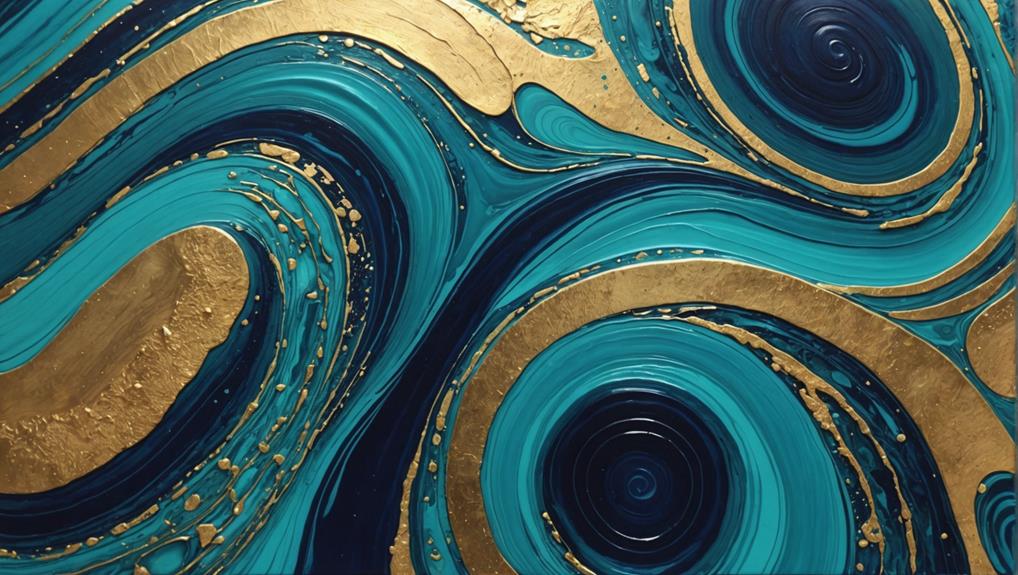
Layering for depth in acrylic pour paintings can be both exciting and complex, with the interplay of transparent and opaque colors creating unique visual effects.
By understanding how color transparency and paint viscosity affect the layering process, artists can achieve rich depth without sacrificing vibrancy.
Ideal layering techniques, such as using a single opaque base layer and mindful application of transparent paints, are essential for maintaining clarity and ensuring that each layer contributes to a cohesive and enthralling piece.
Color Transparency Effects
Transparent and opaque paints interact uniquely in acrylic pour paintings, creating opportunities to enhance depth and vibrancy through strategic layering. The way these paints are layered can greatly influence the final artwork’s visual effects, making it essential to understand how transparency impacts color layering.
Vibrancy Enhancement: When you layer transparent paints over opaque ones, the underlying colors can shine through, enhancing their vibrancy. This effect can create a luminous quality, adding a sense of depth and richness to your painting.
Dilution and Medium Use: By diluting transparent paints with a pouring medium, you can achieve a slightly transparent appearance, allowing some of the base colors to peek through. This technique can add subtle complexity and visual interest, as colors blend and interact in intriguing ways.
Avoiding Unwanted Tones: While layering transparent paints, it’s important to be cautious. Mixing contrasting colors can lead to darker, sometimes muddy hues, which might not be desirable. Strategically using opaque paints beneath transparent layers can help maintain clarity and prevent undesired darkening.
Understanding these transparency effects can empower you to create more dynamic and visually engaging acrylic pour paintings, making each layer contribute to the artwork’s overall depth and brilliance.
Paint Viscosity Differences
Understanding the viscosity differences between paints is essential for effectively layering colors to create depth in acrylic pour paintings. The viscosity impact plays a significant role in the paint flow, determining how colors interact and settle on the canvas.
For instance, thicker paints like Titanium White hold their shape better, offering sharper lines and maintaining vibrant hues. In contrast, more liquid paints, such as Burnt Sienna, spread more easily, creating softer edges and blending seamlessly with other colors.
Transparent paints, with their lower viscosity, tend to stack and darken as they layer, adding a rich depth to the composition. This contrasts with opaque paints, which retain their brightness and stand out more prominently.
The careful selection of pouring mediums can further tweak these effects, allowing artists to adjust the viscosity and opacity of their paints to achieve the desired outcome.
The interplay between different viscosities is vital for achieving distinct visual effects. More viscous paints can create defined patterns, while less viscous ones blend more easily, contributing to the overall harmony or contrast within the artwork.
Understanding these dynamics is key to mastering the art of acrylic pour painting, creating stunning pieces with layers of depth and complexity.
Optimal Layering Techniques
Achieving ideal depth in acrylic pour paintings requires strategic placement of opaque and transparent layers to enhance vibrancy and prevent color dullness. The right layering strategies can make all the difference in creating stunning artworks with rich color depth.
Here are three key tips to keep in mind:
- Start with Opaque Layers: Begin with an opaque layer at the base. This helps in maintaining brightness and prevents the colors from getting muddy. Opaque layers act as a strong foundation, allowing subsequent transparent layers to shine.
- Use Transparent Layers Sparingly: While transparent layers can add beautiful depth, overuse can lead to darker, unexpected hues. Limiting multiple transparent layers ensures that your painting stays vibrant and prevents the formation of dull or brownish tones.
- Mind Your Pouring Medium: The pouring medium can alter the opacity of your paints. Adding water can increase transparency but still retain some opacity, impacting how the layers interact. It’s crucial to understand how your medium affects the final look.
Color Transparency Observations
Observing how transparent and opaque colors interact in acrylic pour paintings reveals vital insights into achieving desired visual effects. By understanding color layering, artists can create visual depth that captivates viewers.
Transparent colors, when layered over opaque ones, can greatly darken the overall hue, leading to richer and more complex visuals. This interplay is vital for achieving the depth that many artists seek in their work.
When acrylic paints are diluted with pouring medium, even typically opaque colors exhibit a degree of transparency, influencing how they interact when layered. For instance, layering two transparent colors usually results in darker shades, enhancing the depth and complexity of the piece.
Conversely, opaque colors tend to maintain their brightness and consistency, providing a steady foundation for layering. The addition of an opaque paint layer can also modify the visibility of underlying transparent colors.
This selective opacity allows artists to create a sense of depth while still showcasing the vibrant transparency beneath. As a result, understanding the transparency levels of each paint is vital for achieving the desired outcomes in color interaction and layering techniques.
Mastering these nuances enables artists to manipulate color and depth effectively in their acrylic pour paintings.
Impact of Layering Techniques
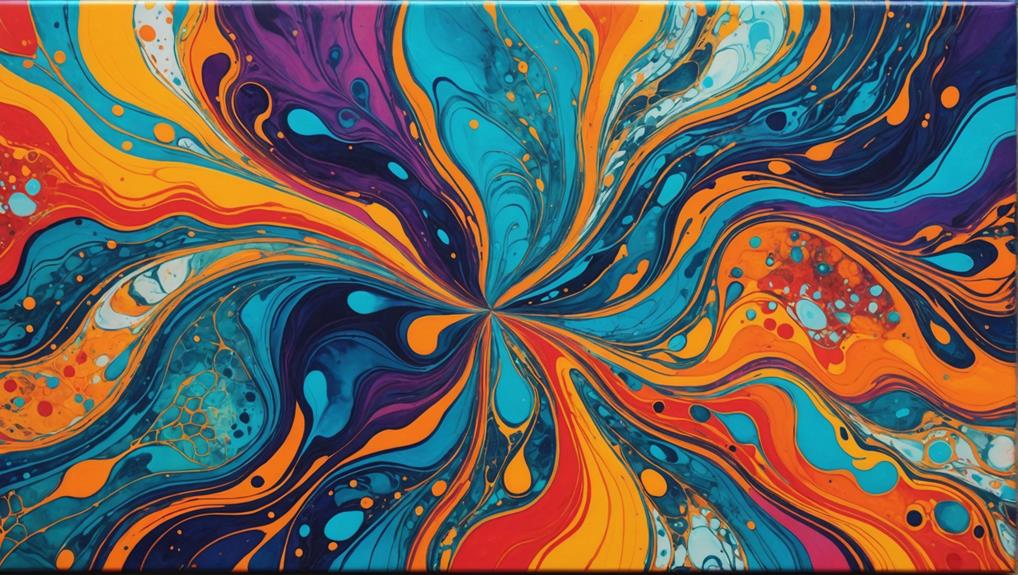
Layering techniques in acrylic pour paintings can dramatically influence the final artwork, where the order of layering plays an essential role.
Using transparent versus opaque paints impacts the vibrancy and depth of the colors, while interactions between contrasting hues can lead to unexpected results.
Strategic application of these techniques can enhance the visual appeal, ensuring the colors remain bright and the composition dynamic.
Layering Order Effects
The order in which colors are layered in acrylic pour paintings greatly influences the final visual outcome, determining the artwork’s vibrancy, depth, and clarity. Layering strategies are essential for achieving desired color depth and preventing unwanted dullness or muddiness in the painting.
Here are three key points to take into account:
- Opaque Base Layer: Begin with a single opaque layer beneath transparent colors to maintain brightness and enhance the overall vibrancy. This approach helps in achieving a striking visual impact without dulling the colors.
- Limit Transparent Layers: Although layering multiple transparent colors can create fascinating effects, it’s important to limit their number. Too many layers can darken the overall result, sometimes leading to unintended brownish tones. Less is often more when it comes to transparent layers.
- Strategic Stacking: Understanding the transparency levels of each paint and strategically stacking them based on color theory can greatly improve the visual outcome. This guarantees a balance between depth and brightness, preventing the artwork from appearing muddy or dull.
Transparency Versus Opacity
Understanding the interplay between transparency and opacity in acrylic pour paintings is vital for mastering the impact of layering techniques on the final artwork.
When you layer transparent paints over opaque colors, you create deeper, richer hues without losing the brightness of the base color. This transparent layering technique helps enhance the visible color spectrum, adding complexity and vibrancy to your piece.
For instance, using opaque colors like Titanium White or Bright Aqua Green as a base guarantees that the vibrancy remains intact. These opaque dynamics keep your colors bright and lively, even when other layers are added on top.
On the other hand, mixing multiple transparent layers can dull the overall appearance, so it’s best to use them sparingly. By placing a single opaque layer beneath your transparent paints, you achieve maximum vibrancy and clarity. This method avoids the potential dulling effect of multiple transparent coats.
Additionally, the mediums you use can greatly alter paint transparency, influencing both vibrancy and depth. As a result, understanding the role of mediums is vital.
Mastering these techniques allows you to create dynamic and engaging acrylic pour paintings, full of depth and vibrant color interactions.
Color Interaction Dynamics
Effective color interaction dynamics in acrylic pour paintings require a strategic approach to layering techniques that maximizes vibrancy and depth. The way colors interact when layered profoundly impacts the final visual outcome, making it vital to understand how different paints work together.
First, let’s talk about using transparent paints over opaque colors. This approach can greatly amplify the visible spectrum, leading to enhanced vibrancy and depth in your artwork. However, be cautious when stacking transparent colors, as they can create darker shades, potentially dulling the piece if overused.
Second, consider the role of opaque colors like Titanium White. These maintain their brightness even when layered, offering clarity and definition to your composition. This is particularly useful for creating highlights and ensuring specific areas stand out.
Lastly, be mindful of color mixing. Combining opposite colors, such as orange and blue, often results in brownish tones, which can diminish the vibrancy of your painting. Strategic color placement is essential to avoid such pitfalls.
Here are three key points to remember:
- Amplify Vibrancy: Use transparent layers over opaque colors.
- Maintain Brightness: Incorporate opaque colors for clarity.
- Strategic Placement: Avoid mixing opposites to prevent dull tones.
Understanding these color dynamics and layering strategies will enhance your acrylic pour paintings, making them more dynamic and visually appealing.
Color Interaction Basics
Layering colors in acrylic pour paintings requires a foundational knowledge of how different hues interact to produce either vibrant or muted results.
Understanding color theory and color perception is essential when planning your pour. For example, transparent paints layered over opaque colors can create darker shades, adding depth and complexity to your artwork because the transparency allows some underlying colors to show through, enriching the visible color spectrum.
However, it’s important to remember that mixing complementary colors, such as orange and blue, can result in dull browns or grays. This outcome highlights the necessity of understanding how colors interact to keep your artwork vibrant. Opaque colors, on the other hand, maintain their brightness and clarity when stacked, making them reliable for defined color areas.
The role of a pouring medium can’t be overlooked either, as it greatly influences the opacity and transparency of the mixed paints. To achieve the desired vibrancy, it’s often recommended to limit multiple transparent layers and use a single opaque layer underneath.
This method helps in maintaining better color definition, ensuring your acrylic pour paintings are both striking and full of depth.
Using Color Wheel Knowledge
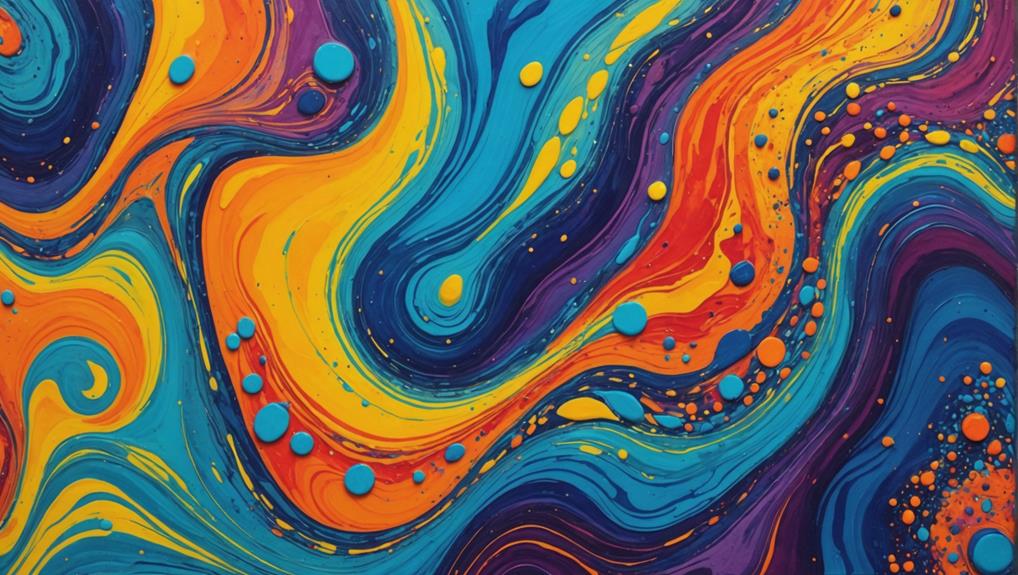
Harnessing the principles of the color wheel enables artists to strategically select and layer hues for achieving harmonious and vibrant acrylic pour paintings. Understanding the color wheel is essential for choosing complementary colors, which can enhance the depth and vibrancy of your artwork. For instance, layering orange and blue—two complementary colors—can produce striking effects, but using white or black as blockers is vital to prevent dullness.
Here are some tips to maximize color harmony in your pours:
- Select Complementary Colors Wisely: Complementary colors, like orange and blue, can create dynamic contrasts. However, be mindful of their interactions to avoid muddiness.
- Use Transparent and Opaque Colors Strategically: Transparent colors tend to darken when layered, while opaque colors maintain their brightness. Knowing which to layer first can help you control the depth and vibrancy.
- Predict Color Outcomes: Familiarity with the color wheel allows you to anticipate how colors will mix. This helps in preventing unwanted brownish tones that can result from combining too many transparent layers.
Medium Selection and Impact
Choosing the right pouring medium can dramatically change how your colors look and interact in acrylic pour paintings.
The medium you select affects the transparency of your paints, which can either boost or dull their vibrancy, making it essential to pick wisely for the effect you want.
Mediums Influence Paint Transparency
The selection of a pouring medium plays an important role in determining the transparency and vibrancy of acrylic paints, directly impacting the final appearance of the artwork. Medium properties greatly influence how transparent or opaque your paint will be, which is vital when layering colors to create depth. Understanding the transparency effects of different mediums can help artists achieve the desired look without unintended color mixing.
Here are three key points to keep in mind:
- Impact on Transparency: Different mediums can alter the transparency of your paint. For instance, adding a fluid medium can increase transparency, making it perfect for subtle layers, while a thicker medium might maintain more opacity.
- Water as a Medium: While adding water can increase transparency, it still retains some opacity. This can be beneficial for creating layers that blend smoothly without losing the integrity of the colors underneath.
- Medium Selection: The right medium guarantees that transparent layers maintain clarity and vibrancy over more opaque layers. Selecting the appropriate medium is important to avoid muddy results and to keep each layer distinct and vibrant.
Understanding these factors will allow artists to control their paint’s transparency effectively, guaranteeing a more polished and dynamic final piece.
Impact on Color Vibrancy
Selecting the appropriate pouring medium not only influences the transparency of acrylic paints but also plays an essential role in enhancing or diminishing color vibrancy in your artwork. When you’re crafting a masterpiece, it’s vital to take into account how different mediums will interact with your paints. Some mediums are like magic potions that boost color intensity, making your hues pop with vibrancy enhancement, while others might accidentally dull your colors.
Imagine you’re layering transparent paints. If you’re not careful, you might end up with unexpectedly darker hues. But here’s a cool trick: placing a single opaque layer beneath those transparent colors can help maintain their brightness and clarity. Think of it as giving your colors a solid foundation to stand out against!
Also, when opaque colors are stacked with transparent ones, they can enhance the vibrancy of the layers underneath, keeping your artwork bright and lively without any muddiness. It’s like having a secret weapon for color depth in your painting arsenal.
Understanding how these mediums and transparency levels interact is key to achieving the stunning effects you’re aiming for in your acrylic pour paintings.
Selecting Appropriate Mediums
Understanding the impact of different pouring mediums is vital for achieving ideal color vibrancy and texture in acrylic pour paintings. The choice of pouring medium greatly alters the opacity and appearance of layered colors, making it essential to select the right one for your project. Different mediums can enhance or diminish color vibrancy, so understanding medium properties and medium compatibility is key.
Here are three tips to help you with medium selection:
- Consider Opacity: Adding water will make your paint more transparent, affecting how colors interact. However, specialized pouring mediums can maintain some opacity, giving you more control over the final outcome.
- Check Viscosity: The thickness of the medium influences how paints layer on top of each other. A medium with the right viscosity guarantees that colors blend smoothly, creating a rich, textured look.
- Use Acrylic-Specific Mediums: Pouring mediums designed for acrylics often provide smoother pours and better color interactions than water or other thinners, resulting in more vibrant and cohesive artworks.
Choosing the right medium can make a considerable difference in your acrylic pour paintings, so take the time to experiment and find what works best for your artistic vision.
Achieving Vibrant Colors
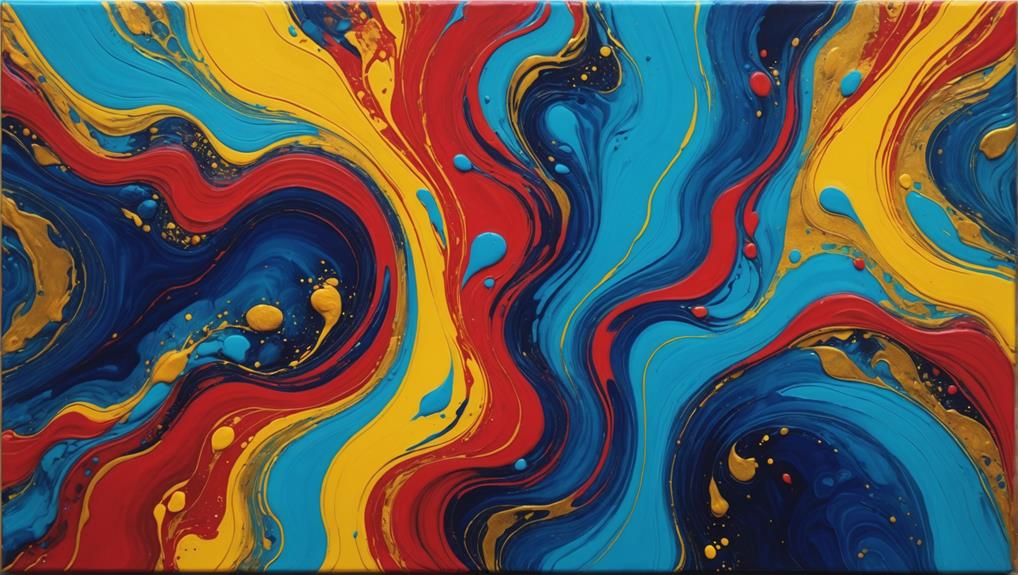
Achieving vibrant colors in acrylic pour paintings requires strategic layering techniques and careful selection of materials. Leveraging color theory and painting techniques, artists can enhance the vibrancy of their work by understanding the interactions between opaque and transparent paints. A single opaque layer laid beneath transparent colors can boost vibrancy, ensuring clarity in the final piece. This method allows for a dynamic color spectrum while steering clear of dull mixtures.
When layering, it’s essential to be mindful of the number of transparent layers used. An excess can lead to darker, less vibrant hues. The choice of pouring medium also plays a vital role; some mediums can greatly enhance color vibrancy while others might diminish it. Selecting the right medium is essential to achieving the desired effect.
To illustrate the effects of layering techniques and mediums:
| Layer Type | Effect on Vibrancy | Best Practices |
|---|---|---|
| Opaque Layer | Enhances base vibrancy | Use as a foundational layer |
| Transparent Layer | Adds depth and richness | Layer over opaque colors |
| Multiple Layers | Can darken and dull | Limit use of transparent layers |
| Pouring Medium | Varies by type | Choose medium that enhances color |
Understanding these factors can greatly impact the vibrancy of your acrylic pour paintings.
Avoiding Unwanted Tones
Maintaining vibrant colors in acrylic pour paintings necessitates careful techniques to avoid unwanted tones that can detract from the composition. The key lies in understanding how to maintain color saturation and achieve tonal balance. By following these strategies, you can keep your artwork bright and lively:
- Limit Transparent Layers: Using too many transparent layers can mix and muddy your colors, resulting in dull, brownish tones. Instead, use a single opaque layer beneath transparent ones to keep your colors clear and vibrant.
- Avoid Complementary Color Mixing: Combining complementary colors like orange and blue can create muddy tones. To prevent this, use white or black as blockers between these colors. This keeps your colors from blending into unwanted shades.
- Balance Layering: Transparent colors stack up to form darker hues. Be mindful of how many layers you’re adding to prevent unintended darkening. A balanced approach helps maintain the intended brightness and tonal balance in your painting.
Understanding color theory and the effects of various mediums on paint opacity is essential. This knowledge will help you make informed decisions, ensuring your acrylic pour paintings remain as vibrant and striking as intended.
Practicing Layering Techniques
Practicing layering techniques in acrylic pour paintings involves a strategic approach to applying paints to achieve desired visual effects and maintain color integrity. One effective layering strategy is to start with a single opaque layer underneath your transparent colors. This technique can enhance vibrancy and prevent those dreaded dark, muddy tones.
When you’re mixing your paints, don’t forget to use a pouring medium to adjust the paint’s viscosity. Just remember, this can also change how opaque or transparent your colors are, so keep an eye on that. Limiting the number of transparent layers is essential because too many can lead to dull, brownish results, which is generally not what you’re aiming for.
Playing around with colors according to their relationships on the color wheel is another smart move. Mixing colors that sit next to each other can create harmonious effects, while mixing opposites can sometimes lead to muted tones.
Experimenting with how different mediums affect color vibrancy will help you select the right combination for your artistic vision. By practicing these layering techniques, you’ll gain a better understanding of how to create depth and richness in your acrylic pour paintings.
Frequently Asked Questions
How to Layer Colors for Acrylic Pouring?
To layer colors for acrylic pouring, consider color density and pouring techniques. Start with a single opaque base, followed by transparent layers. Limit transparent layers to maintain vibrancy, and experiment with color interactions to achieve unique effects.
What Order Do Colors Go in Acrylic Pouring?
For ideal color placement in acrylic pouring techniques, begin with opaque colors at the base and layer transparent colors on top. This approach enhances vibrancy and depth while preventing unwanted muddy hues and maintaining overall clarity.
How Do You Add Depth to an Acrylic Painting?
To add depth to an acrylic painting, employ texture techniques and leverage color psychology. Layering and blending various hues strategically, while integrating textured elements, can enhance the painting’s dimensionality and emotional impact, creating a more dynamic composition.
What Are Good Color Combinations for Pour Painting?
Good color combinations for pour painting include using complementary colors like blue and orange, or warm tones like red and yellow. These combinations provide striking contrasts and enhance the visual appeal of the artwork.
Conclusion
Mastering the art of layering colors in acrylic pour paintings involves careful consideration of paint viscosity, color selection, and technique.
Proper setup, understanding the distinction between opaque and transparent paints, and selecting the right mediums are essential for achieving vibrant and dynamic results.
By practicing various layering techniques and avoiding unwanted tones, one can create visually appealing and depth-rich artworks.
Mastery of these elements will enhance the overall quality and aesthetic of acrylic pour paintings.

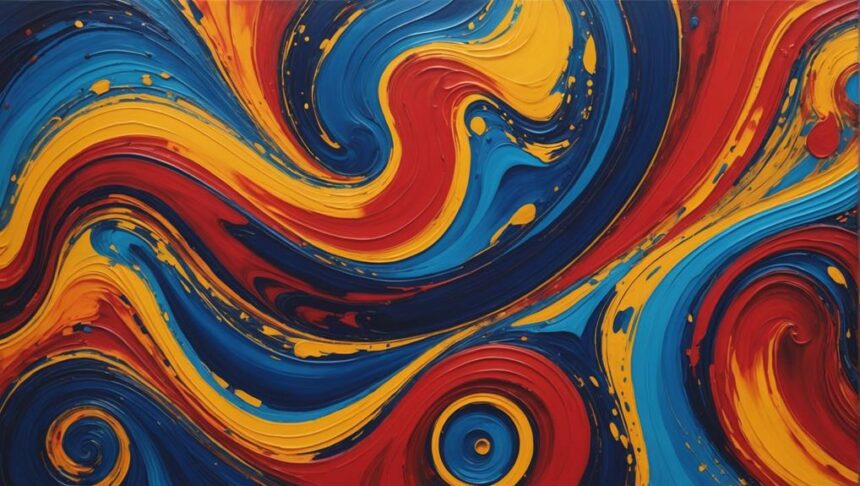
Leave a Reply